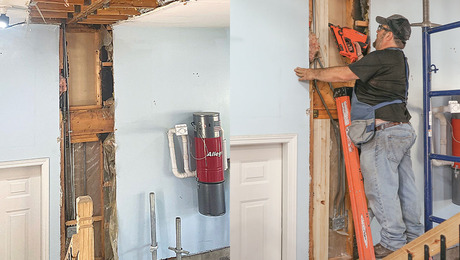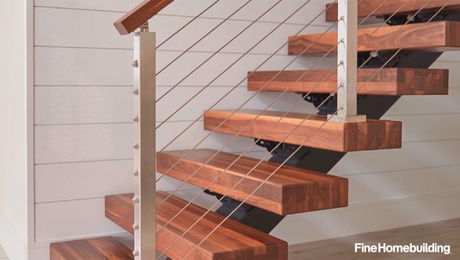Hi. I’m new to this site and new to the internet. My name is Craig. I’ve been a subscriber to Fine Homebuilding since issue #6. I retired from an engineering career about 15 years ago and since have been keeping busy with with old house restoration projects.
My daughter recently purchased an old home in the Philadelphia area. We don’t know when it was built but based on the stone foundation walls, double width structural brick exterior, rough sawn random width 3X joists and knob and tube wiring I would guess about 1900. We need to decide what to do with the basement walls.
They were built of granite stone layed in ‘mortar’ made from silty sandy soil mixed with lime then parged with some kind of lime mix, as near as I can tell. The walls are about 18 inches thick at the base and taper to about 12 inches. Over the years stud walls were built in front of the stone and covered with rock lath and cement plaster, then drywall as the plaster deteriorated from moisture problems. We are removing all that ‘finish.’ What a mess! Rot, mold, insect damage but the joists don’t seem to have been much damaged. The stone walls have sufferred from water damage. They get damp when it rains, seep a little in heavy rain. We have been addressing the issues of grading to promote drainage away from the house. I expect we will be able to solve most of the water problems but will still have some rising damp. The years of water infiltration have deteriorated most of the parging and washed out the lime in the ‘mortar.’ Crumbly dirt remains but in many places there are voids as much as six inches deep.
What to do? We do not want a finished basement. It will be shop space, utility area and laundry. Structural integrity of the walls is the primary concern. I had a masonry contractor look at the situation. He recommends applying two coats of waterproof cement, about an inch or little more, using metal lath where he can. This seems to be the common local practice for dealing with these old stone foundations. But it is against the general recommendations found at this site and elsewhere of not using portland cement mortar to cure dampness in old masonry. However, I’m not convinced it would be the wrong thing to do as it would surface bind the stones and hold the dirt in the wall.
I am wondering if removing as much dirt from the wall as practical using various implements and shop vacs then pointing with lime mortar wouldn’t be a better fix and result in a fairly attractive stone wall?















Replies
Welcome Craig! Great post - I have a house the same age with a similar situation - anxious to read the answers you get! So far, I have a working sump pump (wasn't working when I bought the house), and I've done some grading, fixed gutters to direct water far away from the house, and parged the exposed exterior of the wall (under a porch that I was rebuilding) to at least slow down the critters that appear to run right through the wall. Haven't touched the interior of the stone walls yet.
What kind of shape is your floor in? Mine has a very thin layer of 'crete that is pretty much gone because of the standing water ... I'm thinking about digging out 1 foot of floor and pouring a new slab .... someday.
Bill.
Hi Bill. We got lucky with the floor. Near as I can tell the slab is 2-3 inches and was covered with ceramic tile in 75. The tile man left the date and sign. under the basement steps. Missing tile around the walls where there were built-in cabinets we removed but we found about 100 extra tiles in the celler under the rear porch. We have over 7 feet of head space too since we got rid of the suspended ceiling. Digging out a basement is tough work. Been there. The hard part is carrying all that material out. I think I might be looking for a used belt conveyor or bucket elevator.
Craig